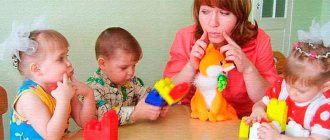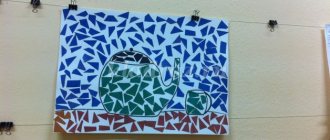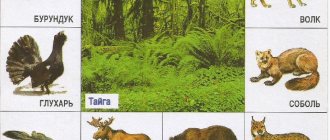Long-term project in the senior group “Mnemonics in the development of coherent speech of preschoolers”
Rukizhat Gazimetovna
Long-term project in the senior group “Mnemonics in the development of coherent speech of preschoolers”
DEPARTMENT OF EDUCATION
ADMINISTRATION OF THE CITY DISTRICT OF Solnechnogorsk
MUNICIPAL BUDGETARY PRESCHOOL EDUCATIONAL INSTITUTION
"Kindergarten No. 42"
Project in the senior group “ Mnemonics in the development of coherent speech of preschoolers ”
Prepared by:
teacher, 1st quarter To.
Ekperova Rukizhat Gazimetovna
Lunevo village
1919
Project goal : development of speech in preschool children through the use of mnemonics
Project objectives :
— to develop children’s ability to work using a mnemonic table when composing descriptive stories, memorizing poems, etc.;
— to develop children’s ability coherently , consistently, and grammatically correctly, to talk about various events from the surrounding life using mnemonics ;
— to develop cultural speech communication skills;
- develop speech , enrich vocabulary, mental processes (memory, attention, thinking, imagination)
.
Project participants : Teacher, children of preparatory school group No. 5 and their parents .
Project implementation period : September – May 2019-2020.
By dominant activity: speech
By number of participants: group
Nature of contacts: among children of the same group
Problem: While working with children in the pre-school group , a problem arose with the fact that their speech is not well developed , they have difficulty talking about the events of their lives, cannot retell literary works, and do not remember poetry well.
Relevance: “If speech is not clear, it will not achieve its goal”
(Aristotle)
.
Type of project : Practice-oriented.
Relevance:
The problem of developing children's coherent speech is well known to a wide range of teaching staff. Knowledge of your native language is not only the ability to construct sentences correctly. Children master their native language through speech activity, through speech perception and speaking . That is why it is so important to create conditions for children’s well- connected speech activity, for communication, for expressing their thoughts.
However, as practice shows, despite the increased interest in the problem, the level of speech development of preschool children is insufficient. Visualization is one of the basic didactic principles of pedagogy. Actions with objects, their visual perception are the first stage in the development of a child’s thinking , therefore it is important to use visual material throughout the entire process. Recently, mnemonic techniques have been widely used in pedagogical practice preschool .
Mnemonics or mnemonics , translated from Greek - “the art of memorization”
is a system of methods and techniques that ensure effective memorization, successful acquisition by children of knowledge about the characteristics of natural objects, the world around them, effective memorization of the structure of a story, preservation and reproduction of information, and of course the
development of speech .
A mnemonic table is a diagram that contains certain information.
Mnemonic tables speed up the memorization process, activate speech activity, develop thinking and imagination.
Mnemonic tables are especially effective when learning poems. The point is this: for each word or small phrase, a picture (image)
; Thus, the entire poem is sketched schematically.
Hypothesis: the effectiveness of the formation of coherent speech in older preschoolers will be significantly increased if you plan and apply mnemonics , as well as apply the integrated use of all means and methods for mastering coherent speech when working with children .
Ways of implementation:
— Working with a mnemonic table on the topic “Seasons”
,
-classes;
-conversations;
— Retelling of the fairy tale “Mitten”
according to
the mnemonic table ;
— didactic and outdoor games;
- Making up riddles. Guessing mnemonic riddles ;
— game situations;
- memorizing poems on the theme “Winter”
, with the involvement of parents
(
mnemonics ) ;
— consultations for parents;
- compiling a mnemonic table for works ;
- compiling a story at home by children together with their parents using a ready-made mnemonic table ;
- individual conversations with parents.
Expected results:
Improving speech coherence ;
Children have developed the ability to speak coherently , consistently, express their thoughts grammatically correctly, and talk about various events from the surrounding life using mnemonics ;
Parents showed great interest in the topic of the project .
Project implementation stages :
Organizational
Assessment of the level of verbal and logical thinking. Statement of the problem and goal. Drawing up a long-term work plan for the project . Determining the goals and objectives of the project , collecting the material necessary to implement the project , predicting the result, developing lesson notes to familiarize children with mnemonics . Showing the interest of parents and helping in the selection of thematic material. Showing interest in the topic of the project and taking part in collecting thematic material. Participation in the survey.
Basic
The tasks of this stage include the implementation of the main activities in the areas of the project : Filling the group space with visual and illustrative material on topics using mnemonic tables , reference pictures, algorithms. Introduction to writing descriptive stories and memorizing poems using mnemonic tables . Familiarity with the basic methods of transcoding information, the use of conditional graphic models by children in games. Compiling riddles, tongue twisters and sayings using mnemonics . Making games and visual aids for children.
Final
Design of exhibitions of children's and parent's works, presentation of the project . Design of visual information in the parent corner.
Plan for phased implementation of the project :
Date: Working with children Working with parents
01/15/2018 Learning physical exercises “Snowman”
according to
the mnemonic table . (Appendix 1)
Tasks:
1. Develop children’s coherent speech through learning a poem by heart, using the mnemonic .
2. Develop children’s ability to answer questions about the content of the poem, using words and expressions from the text.
3. Exercise children in the formation of cognate words (snow - snowflake - bullfinch - Snow Maiden - snowy - snowman - snowfall - snowball).
4. Improve children’s artistic and speech performance skills when reading poems (emotionality, intonation expressiveness of speech )
.
01/16/2018 Memorizing the poem by R. Kudasheva “Here comes the silver winter”
using
mnemonics . . (Appendix 2)
Tasks:
Educational:
1. Enrich, clarify, activate the vocabulary on the topic “Winter”
.
2. Improve the ability to memorize a poem using reference diagrams and pictures.
Developmental:
1. Stimulate the child’s mental and speech activity.
2. Ensure the development of the ability to observe and imagine
3. Ensure the development of dialogical speech and speech hearing.
4. Ensure the development of logical thinking when drawing up diagrams, visual and verbal-logical memory. Educational:
1. Cultivate friendliness and a desire to help.
2. Foster a love of nature.
3. Cause an emotional response when listening to poems about winter, interest in artistic expression. Questioning. “
Mnemonics ” (Appendix 3)
01/17/2018 Work with mnemonics on the topic “Introduction to the winter season”
(Appendix 4)
Purpose.
Increasing the level of curiosity and speech activity of children.
Tasks:
Educational:
— learn to solve dialectical problems using a dialectical unification scheme.
— teach children to compose a story using mnemonic tables , consolidate children’s knowledge about the signs of winter,
— development of coherent speech.
— teach children to answer in complete sentences, activate children’s vocabulary.
Developmental : Develop creative imagination through the use of mnemonic tables ; spatial representations; Development of visual attention, memory, thinking; develop children's attention , memory, coherent speech , and reasoning skills.
Educational: Develop the ability to listen to adults and each other; cultivate a love for nature.
01/18/2018 Compiling riddles using mnemonic tables . (Appendix 5)
Target:
Development of coherent speech in children.
Tasks:
Teach children to invent symbols on their own by compiling, with the help of a teacher, a table with elements of mnemonics . Consultation for parents. (Appendix 6)
" Mnemonics - the art of memorization"
.
Tasks;
-develop basic mental processes - memory, attention, imaginative thinking;
-develop fine motor skills with partial or full graphic reproduction.
01/19/2018 Learning the little rhyme “Naughty Squirrel”
according to
the mnemonic table . (Appendix 7)
Tasks:
Educational:
1. Enrich, clarify, activate the vocabulary.
2. Improve the ability to memorize a poem using reference diagrams and pictures.
Developmental:
1. Stimulate the child’s mental and speech activity.
2. Ensure the development of the ability to observe and imagine
3. Ensure the development of logical thinking when drawing up diagrams, visual and verbal-logical memory.
Educational:
1. Cultivate friendliness and a desire to help.
2. Evoke an emotional response when listening to poems. mnemonic tables at home by children and parents (optional)
.
(Appendix
01/22/2018 Working with mnemonics “Birds of Migratory”
.
(Appendix 9)
Tasks:
- strengthen the ability to listen carefully;
— systematize and consolidate children’s knowledge about migratory birds;
- promote the development of psychological processes: thinking, memory,
attention, imagination, fine motor skills;
- develop intonation expressive speech;
— develop auditory perception.
- cultivate a friendly attitude towards each other, towards living nature;
— create positive motivation for learning;
- consolidate the ability to engage in verbal interaction, participate in
collective conversation.
01/23/2018 Working with mnemonic squares “Proverbs and sayings”
.
(Appendix 10)
Tasks:
- systematically introducing children to the understanding, assimilation and use of proverbs and sayings;
— introduction of proverbs and sayings into children’s speech based on the development of the semantic side of the word. Consultation for teachers. (Appendix 11)
01/24/2018 Retelling of the fairy tale “The Mitten”
according to
the mnemonic table . (Appendix 12)
Tasks:
1. Teach children to retell a familiar fairy tale using a mnemonic table , expressively conveying the dialogue of the characters.
2. Develop attention , memory; the ability to solve riddles based on the visual image of animals and give reasons for your answer.
3. Cultivate interest in fairy tales and curiosity
01/25/2018 • Compiling a story using the mnemonic table “How animals winter”
.
(Appendix 13)
Goal: To create conditions for the development of coherent speech in children through mnemonic tables .
Tasks:
Educational. Teach children to select homogeneous definitions for words, create descriptions of animals using mnemonic tables , using previously acquired knowledge and ideas. Tell a coherent , using figurative words and expressions to describe the animal. Intensify the use of cognate words. Make sentences based on the pictures.
Educational. To cultivate a caring attitude towards native nature and an interest in fiction.
Developmental . Improve the processes of attention, memory, thinking, expand children's vocabulary. Exhibition of works. (Appendix 14)
01/26/2018 Open lesson. (Appendix 15)
Performance:
-Children began to work more actively in classes. They have concentrated observation, attention, memory, perseverance; creative imagination, logical and figurative thinking increased.
-Children learned to correctly formulate their thoughts in the form of a sentence. Speech activity increased, they began to communicate with friends and adults with a desire.
-Learned to compose stories of five or more sentences using their various constructions.
-There was an interest in memorizing poetry;
-Children overcome timidity and shyness, learn to behave freely in front of an audience, speak more competently, notice and correct mistakes in the speech of their comrades .
MAGAZINE Preschooler.RF
“Mnemonics as a means of developing coherent speech in preschoolers”Tarasova Irina Aleksandrovna, teacher of MKDOU kindergarten No. 11, Novosibirsk
“A child will not speak in empty walls” …
E. I. Tikheyeva
Speech is a great gift of nature, thanks to which people receive ample opportunities to communicate with each other. Speech connects people in their activities, helps to understand, shapes views and beliefs, and provides a tremendous service in understanding the world.
An analysis of the current situation in the system of education and training of preschool children has shown that the number of children with an insufficient level of speech development is steadily growing.
The results of the pedagogical diagnostics of my students also confirm the presence of this problem: poor vocabulary, inability to coordinate words in a sentence, inability to construct a monologue: a story on a proposed topic, retelling a text.
The question arose: how and with the help of what methods and technologies can we most effectively solve this problem?
With the introduction of the Federal State Educational Standard for Education, teachers of preschool institutions are actively introducing various pedagogical technologies into practice. When teaching children coherent speech, it is entirely justified to use creative methods, the effectiveness of which is obvious, along with generally accepted ones.
Today, mnemonics are among the easy-to-use, easy, convenient and highly effective techniques for the development of coherent children's speech and accelerated memorization of material by children.
The advisability of using mnemonics in the development of coherent speech in preschool children is that: firstly, a preschool child is very flexible and easy to teach, but most preschool children are characterized by rapid fatigue and loss of interest in activities, which can easily be overcome by increasing interest through the use of visual modeling; secondly, the use of symbolic analogy facilitates and speeds up the process of memorizing and assimilating material, and also develops the skill of practical use of techniques for working with memory; thirdly, using a graphic analogy, we teach children to highlight the main thing, systematize, analyze and synthesize the acquired knowledge.
Therefore, there was a need to develop and implement the “Miracle - Mnemonics” , aimed at developing coherent speech in older preschoolers and increasing the level of development of their speech activity through the use of mnemonics techniques.
Project objectives:
- To develop children’s ability to work using a mnemonic table when composing descriptive stories, retellings, memorizing poems, composing stories, etc.
- To develop children’s ability to express their thoughts coherently, consistently, and grammatically correctly, and to talk about various events from the surrounding life using mnemonics.
- Develop speech, enrich vocabulary, mental processes (memory, attention, thinking, imagination).
- Develop partnerships between parents and teachers in joint activities.
The project is implemented in the process of educational activities, during routine moments, independent activities, and interaction with the families of students.
Work with children is planned in blocks.
And now I want to dwell in more detail on the content of the blocks of work with children under the project and the results of my work.
The block “Small forms of folklore” is a block of work with children using mnemonic tables with pure sayings, nursery rhymes, proverbs, sayings, tongue twisters, counting rhymes, riddles, I use them for the development of children’s speech, in order to teach them to speak expressively, legibly and clearly for the effective development of correct pronunciation .
Block “Memorizing Poems” - thanks to mnemonic tables, children can easily memorize poems of any length. Knowledge of poetry enriches a child’s vocabulary, develops skills in correct pronunciation of words and individual phrases, and develops a culture of speech.
Block “Retelling” - modern children find it difficult to coherently, consistently, and grammatically correctly express their thoughts and talk about various events from the life around them, but thanks to mnemonics, children are very good at retelling the stories they have read.
Block “Working with a fairy tale” - if you tell a fairy tale using mnemonic tables, when children see all the characters, then the child already concentrates his attention on the correct construction of sentences, on reproducing the necessary expressions in his speech.
“Tell Me” block - this block is no less interesting for children, thanks to it, children develop coherent and correct speech and correctly compose descriptive stories.
Block “Come up with a story” - in this block, children can come up with stories themselves using mnemonic tables, which is the development of thinking, memory, attention, and imagination.
Participation in the implementation of this project undoubtedly brings many benefits in the development of speech in children. Over time, the children themselves show interest in creating and depicting mnemonic tables.
As a result of the project, a methodological manual was prepared, including:
- a card index of mnemonic tables for working with children in blocks;
- a card index of didactic games for children's speech development;
- thematic booklets and folders for parents and teachers;
- consultations, methodological recommendations, memos, presentations, questionnaires for teachers and parents.
The expected results came true. Children have developed the ability to work using a mnemonic table when composing descriptive stories, retellings, memorizing poems, composing stories, etc.; children express their thoughts coherently, consistently, and grammatically correctly, talk about various events from the surrounding life with the help of mnemonics, and their vocabulary has been enriched.
Children's interest in fiction has increased, which, in my opinion, is of enormous importance for modern preschoolers.
Competence in organizing and conducting joint creative and speech activities based on mnemonic tables among parents and teachers has increased.
The result of the project also was the creation in a preschool institution of additional conditions for the development of speech in children of senior preschool age.
I am convinced that if mnemonics are used in teaching children coherent speech, this will help the child to be more sociable, his vocabulary will expand, and the child will learn to speak coherently, tell stories and express his thoughts.
| Next > |
The problem of developing children's coherent speech is well known to a wide range of teaching staff. It has long been established that at preschool age significant differences appear in the level of speech of children. My experience as a teacher shows this. The main task of developing a child’s coherent speech is to improve monologue speech. This task is solved through various types of speech activity: retelling literary works, composing descriptive stories about objects, objects, natural phenomena, creating different types of creative stories, memorizing poems, as well as composing stories based on a picture.
In children with speech impairment, the formation of all components of the speech system, including memory, is difficult. If you do not work with such a child, do not work with him on the development of memory, then at school he can expect many problems with his studies. After all, at least 50% of a child’s success depends on good memory. Mnemonics are one of the most effective tools for training memory. This is a kind of visual modeling technique that I use in my work. This method brings excellent results in classes on the development of coherent speech and automation of sounds. In order to achieve the desired effect, teaching mnemonics must be gradual. First stage. To compose phrases and simple sentences, a mnemonic square is used - a separate, schematic drawing that depicts one object, action or phrase.
Second phase. Learning tongue twisters, tongue twisters, describing the seasons, retelling short stories. Everything happens with the help of a mnemonic track - a collage consisting of 3-4 images.
Third stage. Using a mnemonic table - a diagram consisting of several squares containing certain information. It is used to retell a fairy tale, compose a story based on a plot picture or a series of pictures. In each of the squares of the table there is a drawing or a schematic representation of the main points of the plot, that is, all the necessary text is sketched with simple schematic drawings and looking at them, the child easily remembers the information.
The use of mnemonics is a wide range of possibilities for a child. Firstly, memory development occurs, as the process of memorizing speech material becomes much easier. Secondly, mnemonics contributes to the development of speech, developing the skill of composing long descriptive sentences, stories, and retelling the text read. Thirdly, the development of attention in the child is stimulated, because diagrams and tables require focus and concentration in order to fully understand certain actions and the sequence of events.
Thus, from all the work done, we can conclude that the systematic use of mnemonics in the direct educational activities of preschoolers on speech development expands the child’s understanding of the world around him, coherent speech is formed, cognitive activity and communication skills develop, and the active vocabulary is enriched.






